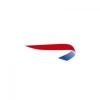Program the frequency of the LOC as NAV1 (Course is 249). Program the frequency of the JHW VOR as NAV2.
Set the courses by rotating the OBS knobs on the NAV1/2 displays so that your desired course is at the top of the compass dial on said display.
Fly to the VOR at 2620ft QFE then turn to outbound course 353 to intercept the LOC. Descend on the glidepath.
You will find that the NAV1 display has 2 lines which cross, whereas the NAV2 display only has one. The vertical line is lateral guidance; if it is right of centre, you are left of the centreline of the radial/course; if it is left of centre, you are right of centreline of the radial/course. This is on both displays. The NAV1 display also has a horisontal line for vertical guidance; if it is above centre, you are below the glidepath; if it is below centre, you are above the glidepath.
Ignore the third NAV display which looks different and is directly beneath the first 2. This is the ADF and is used to locate NDBs. The ADF is far simpler than the VHF radios used to navigate with VORs or ILS/LOC systems. The arrow points to the currently tuned NDB on a compass. The compass dial turns automatically. You follow the arrow to the NDB or the reverse to fly away from it. If there is no signal, the ADF display will lock into a position which is constantly perpendicular to the direction of flight.
One more thing: DME is used to measure the distance from a set point (Usually a VOR or ILS/LOC). Unlike in larger aircraft, DME information is found not with the NAV displays, but in the radio stack. On the DME panel, select the preferred NAV radio (1 or 2) to display the distance and relative ground speed from the beacon. The vast majority of VORs and all ILS/LOCs, that I know of, also transmit DME and I have only come across one beacon which is DME alone (without directional guidance).

Member, Vice-President, and Website Developer of Universal Alliance
 25 JHW.PDF 298.18KB
11 downloads
25 JHW.PDF 298.18KB
11 downloads
 Sign In
Sign In Create Account
Create Account




 Back to top
Back to top











